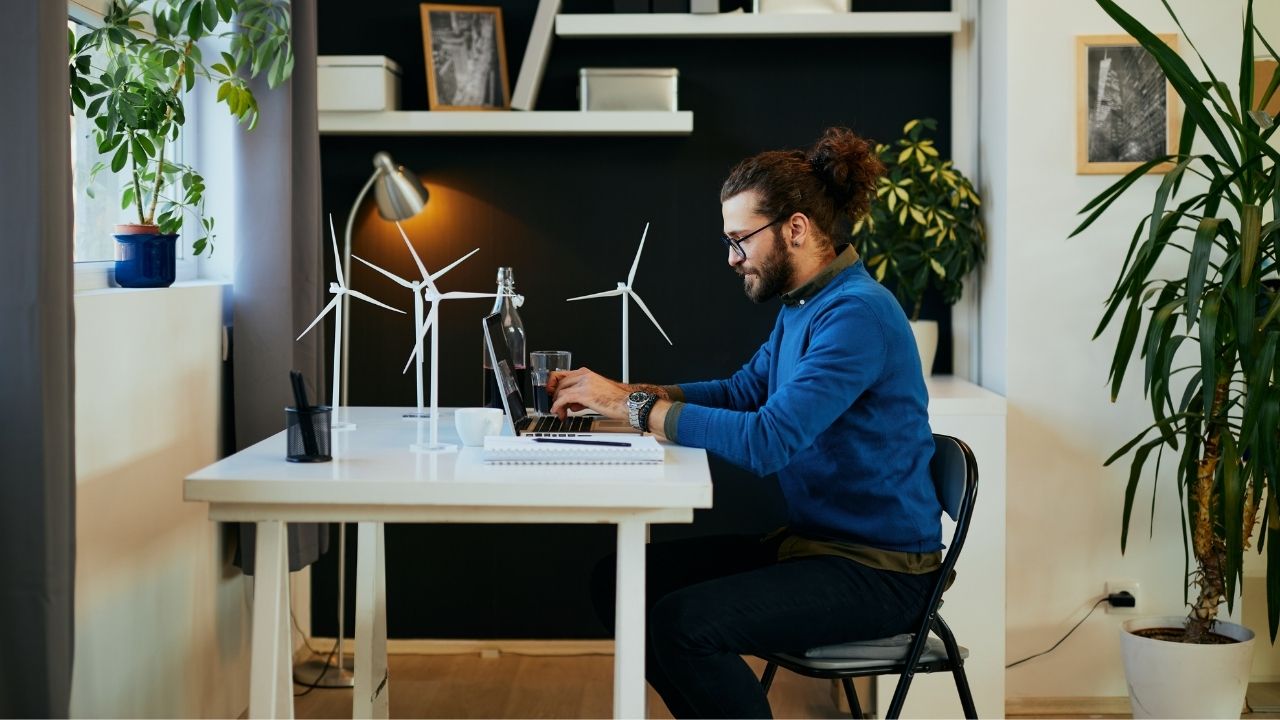- The increase in extreme weather events will inevitably alter everyday life, including daily commutes as well as how, when, and where we work.
- Certain companies are beginning to recognize the risks that climate change poses to their operations; in one report, companies disclosed $1 trillion in potential climate impacts in the near future.
- Coca-Cola, Ikea, and Walmart have committed to 100% renewable energy.
When we think of climate change, most of us think of environmental consequences like rising sea levels, extreme temperatures, wildfires, and melting glaciers.
There are other consequences of climate change that often get overlooked: What it means for your job.
As climate change transforms the planet, the increase in extreme weather events will inevitably alter everyday life, including daily commutes as well as how, when, and where we work.
What are some of the consequences of global warming?
The world is on track to hit 1.5°C of warming by 2040. Everything gets significantly worse at 2°C of warming, which is why it’s so critical to move to a zero-emissions economy.
The 1.5°C of warming seems to be unavoidable at this point, and it will cause major disruptions; extreme heat is going to be a challenge to navigate because it can destroy infrastructure.
In 2019, a highway near St. Louis buckled because of high temperatures, and train tracks warped during a record-setting heat wave in San Francisco.
Another aspect of increased temperatures is the scarcity of water – which will affect every aspect of life.
Precipitation has declined in the tropics and subtropics since 1970. Southern Africa, the Sahel region of Africa, southern Asia, the Mediterranean, and the U.S. Southwest are getting drier. Eventually, these places will run out of drinkable water.
It’s not all doom and gloom though; there are proactive steps that can be taken now if we want to have a normal future in which we can live and work comfortably.
If nothing is done to mitigate global warming, there will be many negative outcomes.
1. Climate change means that some companies may tell workers to work from home.
“Just like we have school and work closures for inclement winter weather—snow days—we’re likely to see ‘heat days,’ where businesses and schools don’t operate, or people telework, because it’s too hot for people to commute safely,” according to David Arkush, managing director for the climate program at the nonprofit Public Citizen.
2. For many workers, remote work isn’t an option. People who work outside will be the hardest hit.
It’s possible that outdoor work may become so dangerous that alternative business models become more common, such as indoor farms. Schedules may also change; in Phoenix, many construction workers already work at night.
3. Low-income workers will suffer.
As more extreme weather events occur, restaurants and stores may have to close for months or go out of business entirely. After Hurricane Sandy, one study found that low-income workers in New Jersey lost $832 million in wages because of the effects of the storm.
4. Workers’ health will suffer and will put a strain on healthcare systems.
Worker health issues that are not associated with exposure to heat will include vector-borne diseases, infectious diseases, malnutrition, stress, and mental health issues.
The risks due to extreme weather events as well as other effects of climate change on society will create major demands on the healthcare system and put workers under great psychological pressure and stress.
5. Public transportation will not be reliable.
If weather conditions become severe, in some cases, employees may not be physically able to make it to work if roads and public transit lines are closed and they live too far from their job to walk.
6. Social inequities will increase.
Although everyone is affected by climate change, not everyone is affected equally. Indigenous people, people of color, and the economically marginalized typically get impacted the most.
Inequities built into our housing, healthcare, and labor systems make these communities more vulnerable to the worst impacts of climate change.
7. Companies will suffer financially due to climate change and attempting to mitigate it.
Certain companies are beginning to recognize the risks that climate change poses to their operations; in one report, companies disclosed $1 trillion in potential climate impacts in the near future.
For example. PG&E (the utility that filed for bankruptcy after its power lines sparked fires in an increasingly hot and dry California) said that increasing wildfires from climate change are a $30 billion risk to its business.
Pharmaceutical giant Eli Lilly recognizes risks from hurricanes, floods, and droughts at its manufacturing plants and warehouses, including in Puerto Rico, where it had to shut down operations during climate-change-fueled Hurricane Maria.
When will climate change begin to affect our work lives?
Public Citizen noted that outdoor workers in Florida are already laboring in unsafe temperatures most of the time. In Central America, some workers are developing kidney disease that appears to be linked to extreme heat stress and dehydration; the same disease may be emerging in California.
For lucky workers who do not have to work outside, companies may adapt their buildings to coexist with global warming.
An increasing number of companies may decide to install backup power at offices—such as solar panels and batteries—along with other resilient design choices, such as building higher in areas at risk of flooding, adding landscaping that can absorb water and dissipate waves, and using flood barriers to keep water out in a worst-case storm, according to Fast Company.
Employees may decide that they want to relocate away from some of the highest-risk areas. Right now, remote working is growing as the high cost of living in desirable cities drives workers away, and climate change will only add to this pressure.
But, when?
One study estimates that more than 300,000 coastal homes in the U.S. are at risk of repeated, chronic flooding by 2045; in the western U.S., by 2040, wildfires will burn areas six times larger.
Nine of the 10 warmest years since 1880 have occurred since 2005—and the 5 warmest years on record have all occurred since 2015.
The impacts of global warming are already harming people around the world.
Antarctica has lost nearly four trillion metric tons of ice since the 1990s, which will continue to make sea levels rise several meters in the next 50 to 150 years – wreaking havoc on coastal communities.
The U.S. saw an unprecedented 22 weather and climate disasters that caused at least a billion dollars’ worth of damage in 2020, but 2017 was the costliest on record and among the deadliest as well: Taken together, that year’s tropical storms caused nearly $300 billion in damage and led to more than 3,300 fatalities, according to the NRDC.
If we’re unable to reduce our emissions, scientists believe that climate change could lead to the deaths of more than 250,000 people around the globe every year and force 100 million people into poverty by 2030.
How can we mitigate climate change?
1. Create greener societies
Humanity can rebuild society in a clean and healthy way with trillions of dollars of stimulus, which will transition us away from fossil fuels to clean infrastructure and industries, which will in turn create millions upon millions of jobs.
2. Utilize coworking spaces more
A Suburban Economic Study revealed the environmental benefits that flexible workspaces will have between now and 2029. The study found that coworking spaces are an unlikely, but effective tool in the fight against climate change.
The same study found that by 2029, flexible offices will reduce carbon emissions globally by the equivalent of 1,280 flights from London to New York each year due to reduced commute times. Workers would also save an average of 7,416 hours each year in reduced commute times, which is equal to 118 metric tons of carbon emissions.
Flexible offices that allow employees to work remotely may reduce carbon dioxide emissions by 214 million tons a year by 2030.
3. Companies should retrofit buildings to make them more energy efficient
Real estate is responsible for 40% of the world’s carbon emissions. This is a depressing statistic, but it can be lowered if humanity puts in the effort.
Green buildings have less negative impact on the environment than standard buildings. Their construction minimizes on-site grading, saves natural resources by using alternative building materials, and recycles construction waste rather than sending it to landfills.
Turning existing buildings into green ones can be done by installing solar, making use of daylight instead of using artificial light, reducing the building’s water consumption by installing low-flow plumbing fixtures, and utilizing energy-saving electrical sockets.
Some companies are already making efforts to inhibit climate change
Unilever, the mega-corporation which makes everything from Dove soap to Magnum ice cream, has pledged serious action on a variety of sustainability initiatives – including sourcing 100% of its energy for production from renewable sources by 2030 (it already cut its carbon emissions by 43% from 2008 to 2016).
Other companies are working on similarly ambitious initiatives, such as Coca-Cola, Ikea, and Walmart, which have all committed to 100% renewable energy.
Companies need to ensure that they’re not just focused on short-term profit, but instead on climate change resilience strategies.
Governments and their national and local agencies, employers, workers, and their organizations need to discuss and agree on effective policies and prevention programs that will sustain and improve productivity and workers’ health during the impending climate crisis.


 Dr. Gleb Tsipursky – The Office Whisperer
Dr. Gleb Tsipursky – The Office Whisperer Nirit Cohen – WorkFutures
Nirit Cohen – WorkFutures Angela Howard – Culture Expert
Angela Howard – Culture Expert Drew Jones – Design & Innovation
Drew Jones – Design & Innovation Jonathan Price – CRE & Flex Expert
Jonathan Price – CRE & Flex Expert














